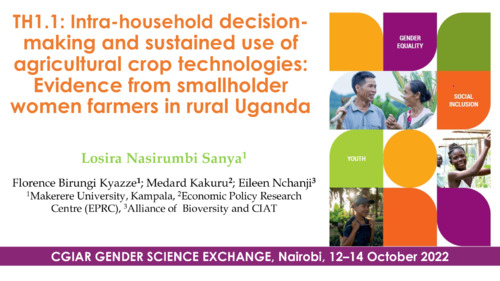TH1.1: Intra-household decision-making and sustained use of agricultural crop technologies: Evidence from smallholder women farmers in rural Uganda
This research used a mixed method approach to examine how intra-household decision-making patterns shape sustained use of crop technologies among agricultural rural households in eastern Uganda. We estimate how empowerment in decision making, measured using indicators drawn from the project level Women's Empowerment in Agriculture Index mediates sustained use of improved crop varieties. Further, spousal differences in decision-making power and technology use are examined. The results indicate that both men and women use diverse improved crop varieties for different purposes. Overall, we observe differential patterns of use of improved crop varieties with a high proportion of women reporting sustained use of food-related crops while a high proportion of men report income crops. There was a significant association between level of decision making power and sustained use of improved crops by men and women. Women with higher level of participation in decision making power have more sustained use of improved varieties for the main crops grown. Note to be taken that a gender gap still exists in access to improved varieties with men having 6years of use on average as compared to 5 years for women. We also find significant differences between men and women in the same household in their rating of the distribution and extent of involvement in key decisions with less agreement (and mis-attribution) observed among men and women in decision-making scores. Women decision makers tend to allocate themselves higher scores than was assigned to them by their counterparts. We conclude that women's empowerment in decision making has potential to contribute to closing the gender gap in sustained use of agricultural technologies. We therefore need to be more intentional about women's participation, decision making and agency in development interventions if we are to achieve greater impacts in sustained use of agricultural technologies towards better livelihoods.

